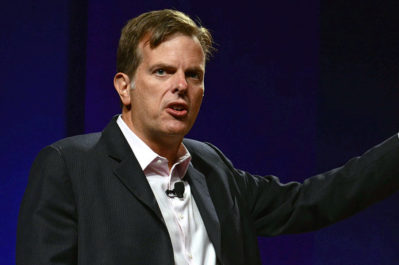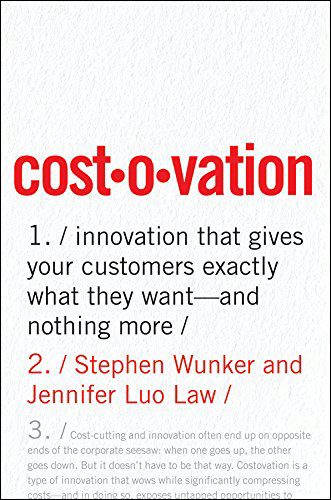In highly competitive markets, companies might try to differentiate themselves by adding more and more perks, features, or services. But more isn’t always better. In this episode of Mastering Innovation on Sirius XM Channel 132, Business Radio Powered by The Wharton School, Steve Wunker, Managing Director of New Markets Advisors, discussed the costs of innovation and how to keep them low while executing new strategies.
In his new book, Costovation: Innovation That Gives Your Customers Exactly What They Want–And Nothing More, Wunker examines the improvements of major companies that were both cost-effective and beneficial to their customers. He discusses the signs that an industry is ripe for cost-cutting innovation, such as expensive features and over-complicated processes. Citing examples from Toyota, Retro Fitness, and others, Wunker emphasizes the importance of efficiency and improving upon a product or service while bringing the cost down for everyone.
An excerpt of the interview is transcribed below. Listen to more episodes here.
Transcript

Harbir Singh: You talked in your book about Toyota, how they have modularized the manufacturing process, and their early five variations of platforms. There’s a very compelling description of a large company taking cost out through significant process changes. What I was wondering was, why does Nissan not do that?
Steve Wunker: Just like the Toyota production system was a hard method for manufacturing companies to implement, so, too, is this modular platform. It requires a real strategic focus to trade off a lot of things that you won’t be able to do because you have that modular platform. Once you make that decision, then it also anchors you in a part of the market. You really have to understand the market and have the strategic courage to double down on that part of the market where you think you can win, and then make some very rigorous cost trade-off decisions.
Toyota vehicles are very well-made vehicles, but they are certainly not one-size-fits-all. This isn’t a brand catering to all ends of the market. They’ve been able, with this modular production system, to do that. Volvo is doing it as well, but a lot of automakers haven’t gone that far yet.
“You really have to understand the market and have the strategic courage to double down on that part of the market where you think you can win.” – Stephen Wunker
Singh: Part of what you’re saying is that you start with the customer value proposition, and then look at process. You have a chapter on process where you talk about how you might reconfigure the process to have a superior value proposition. Towards the end you have this idea about seven signs that your industry is right for costovation: expensive features, expensive customers, expensive sales, and so on. What proportion of the economy do you think has industries that are vulnerable to costovation? I know this is a big question, but you can answer it any way you want. For example, my cable bill is very high. My cable bill annoys me. Are they subject to costovation? Very big bills, lots of added services, complexity. When we want to change, there’s a non-transparent bundling of, “Okay, we can bundle it differently.” I suppose T-Mobile is disrupting that model to some extent.

Wunker: Yes, they are. Netflix and Hulu, they are too, right? They’re allowing people to cut the cord. They’re enabling folks to unbundle, and not necessarily require everything, all the functionality, and the picture in the picture, and the 139 channels that nobody will pay attention to because they’re only interested in three. There’s much more of an à la carte option.
If you take an industry like medical devices, we have an example in the book about pacemakers. Your typical high-end pacemaker today, which predominates among pacemakers that are sold, has around 90 settings that a physician can configure before they implant it. The average physician configures zero right out of the box into the heart. There was an opportunity there to cater, not to the high-end specialist that wanted everything, but to those people who implanted these things directly into the heart — to sell to those folks not in a super consultative way, where the sales rep has to be in the operating room, but in a much more transactional manner.
Medtronic did that. Given that it was the company that invented the pacemaker, that was revolutionary. They created a separate unit, a perfectly adequate but not hyper-configurable device, and sold it over the internet. If people wanted special support, they would have to be billed for it by the minute. That has positioned them in a different segment of the market that they were rapidly losing to: low-cost competitors from elsewhere. If it works in pacemakers, if it works in cable TV, there is a pretty robust applicability here.
Singh: I saw that you’ve worked with Harvard professor Clay Christensen. He is well known for his work on disruptive innovation. In your book you reference the idea of disruption. How does your model kind of build on that, or how is it orthogonal to that?
Wunker: One of the key mechanisms of disruptive innovation is when a bunch of the market is being delivered over-complex, over-expensive solutions. Somebody comes in with a good-enough, simple, inexpensive solution and ends up cleaning up, taking a bunch of the market away. That lower-end pacemaker is an example of a disruptive innovation.
Clay’s work — and I worked very closely with Clay for six years — points out the strategic vulnerabilities of companies. But he does not go in-depth in his writings about how you accomplish that, how you achieve that radical step in cost position to enable disruption. This was a gap in the literature that we really want to target with this work that we’ve done.
“One of the key mechanisms of disruptive innovation is when the market is being delivered over-complex, over-expensive solutions.” – Stephen Wunker
Singh: Very interesting. If you look at another domain that really sort of meets your standard of industries that are vulnerable to disruption, you can think about some other domains in healthcare. The question is, with the incentives being so strong to cut cost, there may be some good examples of frugal innovation in healthcare beyond medical devices. Do you see a significant wave of change in healthcare services that might pick up on costovation?
Wunker: Yes, very much so. As you mentioned, the incentives have become around cutting costs. It used to be that the balkanization of healthcare — into the health insurers, healthcare providers like hospitals, and their physicians, who were independent of the hospitals — made it too hard to coordinate incentives. By and large, the incentives are now coming on to the provider organization: to the hospital or the healthcare system that’s delivering care. They have a lot of incentive to cut the cost.
So you see institutions like Cleveland Clinic, which are certainly extremely august institutions, instituting things like an eICU, where people can reside in one central facility and check on dozens and dozens of patients at any one time. This enables both lower-cost care but also higher-quality care because you can get extremely specialized physicians being essentially at a virtual bedside with patients who might be in very far-flung locations but require that kind of specialized care.
That’s an important principle of costovation. We’re not talking about giving people stuff that they hate because it’s low cost. We’re not talking about nickel-and-diming. This focus is on things that serve customers really well, that delight them, that are also low-cost.
About Our Guest
Steve Wunker led development of one of the world’s first smartphones and has advised leading companies on growth and innovation since 2004. He has a long track record of creating successful ventures for his own companies and on behalf of clients. He is also a frequent writer and speaker on how firms can create new growth platforms. His award-winning books include Capturing New Markets (McGraw-Hill, 2011) and Jobs to be Done (Amacom/HarperCollins, 2016). His latest book is Costovation (HarperCollins, August 2018).
Mastering Innovation is live on Thursdays at 4:00 p.m. ET. Listen to more episodes here.



